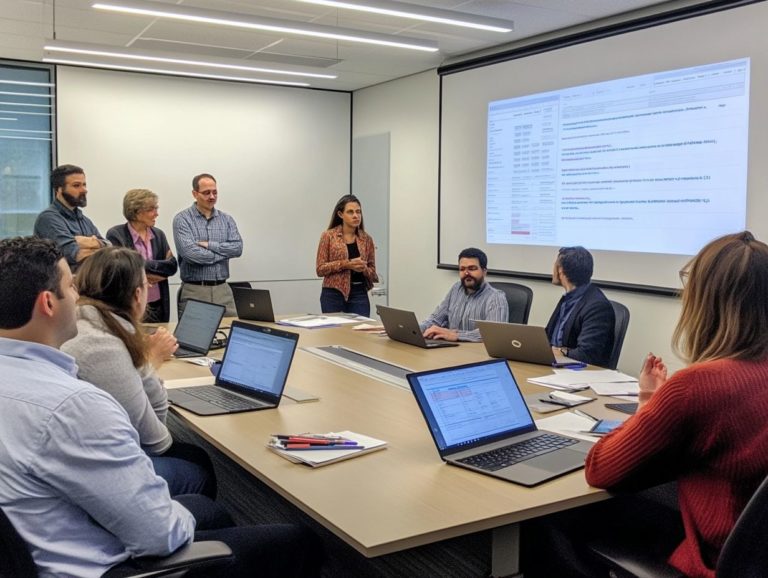how to develop a risk management plan
Risk management is a cornerstone of any thriving organization, protecting your resources and paving the way for long-term sustainability.
Get ready to discover what risk management means and why it s vital for your success! You’ll learn how to identify potential risks and gain insight into effective techniques for assessing them.
You ll also learn how to craft a robust risk management plan, execute it smoothly, and monitor its effectiveness as you go. It will also address common challenges you might encounter and equip you with strategies to overcome them, ensuring your organization remains resilient in the face of uncertainty.
Contents
- Key Takeaways:
- Understanding Risk Management
- Identifying Potential Risks
- Developing a Risk Management Plan
- Implementing and Monitoring the Plan
- Reviewing and Updating the Plan
- Common Challenges in Risk Management
- Preguntas Frecuentes
- Qu es un plan de gesti n de riesgos y por qu es importante desarrollarlo?
- Cu les son los componentes clave de un plan de gesti n de riesgos?
- C mo puedo identificar riesgos potenciales para mi proyecto u organizaci n?
- Cu les son algunas estrategias comunes de gesti n de riesgos que se pueden implementar?
- Con qu frecuencia debe revisarse y actualizarse un plan de gesti n de riesgos?
- Cu les son algunas mejores pr cticas para desarrollar un plan de gesti n de riesgos eficaz?
Key Takeaways:

Developing a risk management plan is crucial for organizations. It helps identify and mitigate risks that could impact success.
An effective risk management plan involves understanding the definition and importance of risk management, identifying potential risks through various techniques, and implementing mitigation strategies. To ensure the success of the plan, continuously review and update it, overcome challenges, and adapt to changing circumstances.
Understanding Risk Management
Understanding risk management is crucial for you as a project manager striving for success. It requires a systematic approach to identify, assess, and mitigate risks throughout the project life cycle. This ensures that you effectively manage constraints like budget and timeline.
The cornerstone of successful project management is your ability to establish a comprehensive risk management plan that documents and registers potential risks. This fosters positive communication with stakeholders and enhances the overall quality of your project.
Definition and Importance
Risk management is a structured approach to identifying, assessing, and responding to risks that could impact your project s success. This process is essential for understanding potential risk factors that might adversely influence timelines, budgets, and resource allocation.
By evaluating the likelihood and potential impact of each risk, you can prioritize your responses and craft tailored strategies to minimize negative consequences. Effective risk management not only shields your project from unexpected challenges but also enhances your decision-making process, promoting a culture of proactive problem-solving.
Ultimately, it keeps your stakeholders informed and prepared, paving the way for smoother project execution while maximizing your opportunities for success.
Identifying Potential Risks
Identifying potential risks is an essential step in your risk management process. Here, you recognize and categorize various risk factors that could impact the success of your project.
By meticulously assessing these risks, you position yourself to navigate challenges effectively and enhance your project’s likelihood of success.
Risk Assessment Techniques
Risk assessment techniques equip you with essential tools to analyze potential risks, prioritize them, and gauge their likely impact on your project goals.
Among these techniques, the risk analysis matrix stands out as an invaluable method, enabling you to visualize the likelihood and severity of various threats.
By categorizing risks into high, medium, or low priority, this tool helps you and your stakeholders focus on the most critical issues that could jeopardize project success.
Incorporating scenario analysis and qualitative risk assessment can elevate your decision-making process, offering a comprehensive perspective on how uncertainties might influence timelines and resources.
Altogether, these methods promote a proactive approach to risk management, ensuring that potential disruptions are identified and mitigated before they escalate.
Developing a Risk Management Plan

Crafting a comprehensive risk management plan is essential for managing identified risks throughout the project life cycle.
This proactive approach significantly boosts your chances of successfully achieving your project goals.
Start crafting your risk management plan today to secure your project’s future!
Key Components and Strategies
Key components and strategies of your risk management plan should include risk mitigation strategies, risk response plans, and ongoing risk monitoring to ensure effective management of potential risks.
These elements are the foundation of a successful approach. Risk mitigation strategies focus on minimizing potential impacts through proactive measures like implementing safety protocols and training programs.
Crafting robust risk response plans allows your team to swiftly tackle unforeseen challenges by outlining specific actions and assigning roles during crises.
Continuous monitoring techniques, including regular audits and data analysis, are vital for identifying emerging risks and assessing the effectiveness of your existing strategies.
By integrating these essential components, you can build a strong culture of readiness, ensuring resilience against both anticipated and unexpected threats.
Implementing and Monitoring the Plan
Implementing and monitoring the risk management plan is essential during project execution. By addressing risks proactively and efficiently, you can ensure that the quality of the project remains intact.
Mastering Risk Mitigation Strategies for Project Success
Effective risk mitigation strategies are crucial for minimizing the impact of identified risks on your project’s success. These strategies allow you to take a proactive stance in identifying, assessing, and responding to potential challenges that could impede your project objectives.
By implementing a dynamic risk response plan, your project team can effectively address uncertainties, ensuring that resources and responsibilities are allocated efficiently. Encouraging a culture of risk ownership among your team members boosts accountability, empowering individuals to take the initiative in monitoring and managing risks.
This collaborative focus not only enhances your decision-making processes but also leads to improved project outcomes by fostering an environment where risks are openly discussed and confronted directly.
Reviewing and Updating the Plan
Make regular reviews and updates to your risk management plan a priority! Regularly reviewing and updating your plan is crucial for maintaining its effectiveness and ensuring it adapts seamlessly to the evolving project circumstances and shifting risk landscapes.
This proactive approach safeguards your project’s success and empowers you to stay ahead of potential challenges.
Continuous Improvement and Adaptation

Continuous improvement and adaptation are essential for maintaining an effective risk management plan throughout the various phases of your projects. These principles enable you to respond swiftly to evolving threats and opportunities, creating a flexible way to manage risks.
By regularly assessing the effectiveness of your current strategies and incorporating feedback from stakeholders, you create a framework that addresses immediate challenges and prepares you for future uncertainties.
This iterative process allows your team to spot potential risks early on, enhancing your ability to communicate effectively about those risks and ensuring everyone stays informed and engaged.
Ultimately, by embracing continuous improvement, you develop a more resilient and proactive risk management strategy, setting the stage for sustainable success.
Common Challenges in Risk Management
Common challenges in risk management can significantly impede the quality and success of your projects. It’s essential to implement effective strategies that not only address these challenges but also empower you to overcome them with confidence.
Are you ready to elevate your risk management game? A robust risk management plan will not only protect your project but also empower your team to face challenges head-on.
How to Overcome and Address Challenges
Overcoming and addressing challenges in risk management requires you to use effective risk strategies while maintaining clear communication about risks to enhance your project s success.
To achieve this, consider adopting proactive risk assessment techniques, such as regular SWOT (Strengths, Weaknesses, Opportunities, Threats) analyses and scenario planning. These methods enable you to identify potential pitfalls early in the project lifecycle.
Integrating collaborative tools fosters transparency among your team members, ensuring that everyone remains informed about the evolving risk landscape.
By cultivating a culture of continuous improvement and ongoing training, your teams will become more adept at responding to unexpected issues. These strategies simplify risk management and empower stakeholders to engage in robust planning, ultimately safeguarding your project s objectives and promoting resilience.
Preguntas Frecuentes
Qu es un plan de gesti n de riesgos y por qu es importante desarrollarlo?
Un plan de gesti n de riesgos es un documento estrat gico que describe los riesgos y peligros potenciales que podr an afectar un proyecto u organizaci n, y los pasos que se tomar n para mitigar, monitorear y responder a estos riesgos. Es importante desarrollar un plan de gesti n de riesgos para asegurar una gesti n proactiva y efectiva, minimizando su impacto y maximizando las posibilidades de xito.
Cu les son los componentes clave de un plan de gesti n de riesgos?

Un plan de gesti n de riesgos t picamente incluye los siguientes componentes:
- Identificaci n de riesgos potenciales
- Evaluaci n y priorizaci n de riesgos
- Desarrollo de estrategias y t cticas de gesti n de riesgos
- Implementaci n de medidas de gesti n de riesgos
- Monitoreo y revisi n regular de los riesgos
- Protocolos de comunicaci n e informes
- Planificaci n de contingencias
C mo puedo identificar riesgos potenciales para mi proyecto u organizaci n?
Existen varios m todos para identificar riesgos potenciales, incluyendo:
- Realizar un an lisis exhaustivo de los datos y la historia del proyecto u organizaci n
- Sesiones de lluvia de ideas con partes interesadas clave
- Consultar con expertos en la materia
- Realizar un an lisis FODA (fortalezas, oportunidades, debilidades, amenazas)
- Revisar las mejores pr cticas y est ndares de la industria
Cu les son algunas estrategias comunes de gesti n de riesgos que se pueden implementar?
Algunas estrategias comunes de gesti n de riesgos incluyen:
- Evitar: eliminar el riesgo por completo
- Transferir: desplazar el riesgo a otra parte a trav s de seguros o contratos
- Mitigar: reducir el impacto o la probabilidad del riesgo
- Aceptar: aceptar conscientemente el riesgo y sus posibles consecuencias
- Planificaci n de contingencias: desarrollar planes de respaldo en caso de que ocurra un riesgo
Con qu frecuencia debe revisarse y actualizarse un plan de gesti n de riesgos?
Un plan de gesti n de riesgos debe revisarse y actualizarse regularmente, particularmente cuando ocurren cambios significativos en el proyecto, la organizaci n o el entorno externo. Se recomienda revisar el plan al menos una vez al a o, o cada vez que haya cambios importantes en los riesgos que se est n gestionando.
Cu les son algunas mejores pr cticas para desarrollar un plan de gesti n de riesgos eficaz?
Algunas mejores pr cticas para desarrollar un plan de gesti n de riesgos eficaz incluyen:
- Involucrar a todas las partes interesadas clave en el proceso
- Utilizar un enfoque sistem tico para identificar y evaluar riesgos
- Crear un plan de gesti n de riesgos que est adaptado a las necesidades y objetivos espec ficos del proyecto o la organizaci n
- Comunicar y actualizar regularmente a las partes interesadas sobre los riesgos y las estrategias de gesti n de riesgos
- Monitorear y evaluar continuamente la efectividad del plan de gesti n de riesgos
Ready to create a robust risk management plan? Start today!






